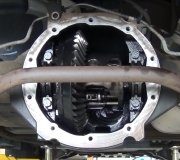I don't believe the differential is serviceable, other than replacement. The procedure is rather involved, and a lift is adviseable. Here is the literary portion of the instructions, reply if you would like the pictures, there are a lot of them.
Rear Axle - Replacement
Differential Replacement
Removal Procedure
Set the parking brake.
Raise and support the vehicle. Refer to Vehicle Lifting.
Remove the right rear tire and wheel assembly.
Place a drain pan beneath the differential.
Remove the differential drain plug (2).
Drain the rear differential gear oil.
Disconnect the electrical connector from the clutch pump check valve.
Remove the right rear wheel drive shaft.
Remove the front propeller shaft.
Place an adjustable support beneath the torque tube.
Loosen, but do not remove the torque tube-to-bracket through bolt (7) and nut (1).
Remove the bolts (5) from the torque tube bracket (4).
Remove the differential carrier-to-cradle mounting bolts (5), nuts (1), washers (2), and mounts (3, 4) from the differential.
Important: During the removal of the wheel drive shaft, the differential output shaft may become disengaged from the differential. If this occurs, firmly grasp and separate the output shaft from the wheel drive shaft. Align the splines on the output shaft to the differential and reposition the output shaft to the differential.
While simultaneously moving the differential assembly to the right side of the vehicle, disengage the left wheel drive shaft from the differential.
Remove the rear differential and torque tube as an assembly.
Remove the torque tube (1) from the differential (2).
Installation Procedure
Install the torque tube (1) to the differential.
Install the rear differential and torque tube assembly to the suspension cradle. Simultaneously guide the left wheel drive shaft onto the differential output shaft while positioning the differential assembly to the suspension cradle.
Place an adjustable support under the torque tube.
Ensure that the left wheel drive shaft is fully engaged to the differential output shaft.
Notice: Refer to Fastener Notice in Service Precautions.
Install the differential carrier mounts (3, 4), washers (2), bolts (5), and nuts (1) to the differential. Tighten the differential carrier-to-cradle mounting bolts to 50 Nm (37 ft. Lbs.).
Install the torque tube bracket-to-body bolts (5).
Tighten the torque tube bracket-to-body bolts to 55 Nm (41 ft. Lbs.).
Tighten the torque tube-to-bracket through bolt and nut to 64 Nm (47 ft. Lbs.).
Install the front propeller shaft.
Install the right rear wheel drive shaft.
Install the right rear tire and wheel assembly.
Install the differential drain plug (2) and gasket to the differential. Tighten the drain plug to 32 Nm (23 ft. Lbs.).
Remove the differential fill plug (1).
Fill the axle with synthetic gear oil.
Inspect the differential oil level to ensure it is even with, to no lower than, 6 mm (0.25 inch) below the opening of the fill hole.
Install the differential fill plug (1) and gasket. Tighten the fill plug to 32 Nm (23 ft. Lbs.).
Connect the electrical connector to the clutch pump check valve.
Remove the adjustable support from the torque tube.
Lower the vehicle.
Operate the vehicle making tight left, then right turns in order to engage the all-wheel-drive system and distribute the gear oil throughout the differential.
Raise and support the vehicle. Refer to Vehicle Lifting.
Remove the differential fill plug,
Fill the axle with synthetic gear oil.
Inspect the differential oil level to ensure it is even with, to no lower than, 6 mm (0.25 inch) below the opening of the fill hole.
Install the differential fill plug and gasket. Tighten the fill plug to 32 Nm (23 ft. Lbs.).
Lower the vehicle.
Friday, August 5th, 2011 AT 2:35 AM


